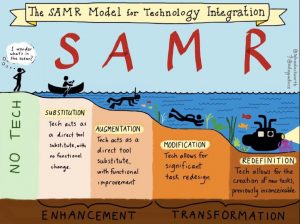As I was reflecting on the concepts of PCK and TPCK this week, I was reminded of the importance of planning as part of sound PK whether with an additional C or T or just in general. Specifically, the idea of “backwards design”, or “assessment up” planning, where teachers start with the end in the mind, usually the assessment of specific curriculum expectations to be demonstrated in a certain way, and then work back from that end point to discover the nitty gritty of content delivery to best position students to be successful in their eventual learning demonstration.
I believe this is a foundational practice for teachers who produce successful learners and who hope to use a technology integration framework, such as TPCK, or analyze their current and future integration using the SAMR lens, effectively. As with all things that get suggested for teachers to do or add or implement for their practice, however, it becomes a question of how does one start? There is a lack of time and a sense of wasting one’s time “re-inventing the wheel” that goes unaddressed. Having some guidance already prepared to assist teachers in their backwards planning with TPCK goes a long way, in my opinion. Like others mentioned in their posts, this is not my first exposure to TPACK. A 2009 paper by Harris, Mishra & Koehler included the importance of adding what they’ve termed “Learning Activity Types” to the toolkit of the teacher using TPCK to backwards plan lessons that provide higher level/rich-technology integration. It’s not enough just to know what we want to teach and try to fit technology in as an afterthought. As Mishra and Koehler (2006) mentioned, “Merely introducing technology into the educational process is not enough” (p.1018). These authors go further in their 2009 paper and state, “effective teaching requires knowledge of both the activity types that are appropriate for teaching specific content and the manners in which particular technologies can be utilized as part of the lesson, project, or unit design” (p.406, emphasis added). This, to me, sounds like the essence of backwards design planning.
I once took an ISTE Schoology Course (cleverly named iPadeology) which had specific resource pages about TPCK, SAMR, differentiation with technology, and various instructional models, including STEM. They provided two very useful forms (licensed under Creative Commons for our use) that I’d saved and wanted to share in light of this week’s topic. I hope you find them useful:
On a personal professional note, I’ve recently found myself applying some PK in my creation of group structures for our school’s newly formed Minecraft: Education Edition STEAM Club. This year’s club challenge is building our school, to scale, where 1 metre = 1 Minecraft block. There are many different areas in our school to be measured, graphed, and built and I’ve spent the last week creating multi-grade zone crews to oversee each area. As I finished, I suddenly recalled something I’d read in a previous MET course about the effects of gender on gaming technology behaviour. The gist of the relevant findings of the research study were that when dual genders were given the chance to play a digital game, the girls always back-seated themselves while the boys took over. However, if placed in same gender groupings, the girls often excelled, taking risks, learning socially from each other, and expressing a greater sense of accomplishment, satisfaction, and enjoyment with the game and with themselves as users of technology. I think this relates to the Math confidence piece Christopher brought up in the news article he posted in announcements this week, as well. I wanted to give the girls just as much opportunity to problem solve, get “mathy”, and create with this challenge as the boys, and I believe my initial grouping based on “fairness” was actually about to work against that. Therefore, I revamped my entire crew list to reflect this research-enhanced PK and will hopefully provide an equally fun and fulfilling learning experience for both boys and girls. If I had actively been using a framework guide for TPCK such as the one provided above, I wonder if I would have tweaked the memory of that research before I started the planning, rather than having it come up as a sort of pedagogically sound coincidence? It certainly would have saved me time!
References
Harris, J., Mishra, P., & Koehler, M. (2009). Teachers’ Technological Pedagogical Content Knowledge and Learning Activity Types. Journal of Research on Technology in Education, 41(4), 393–416. Retrieved from ERIC database. (EJ844273)
Mishra, P., & Koehler, M. (2006). Technological pedagogical content knowledge: A framework for teacher knowledge. The Teachers College Record, 108(6), 1017-1054. Retrieved from http://one2oneheights.pbworks.com/f/MISHRA_PUNYA.pdf
